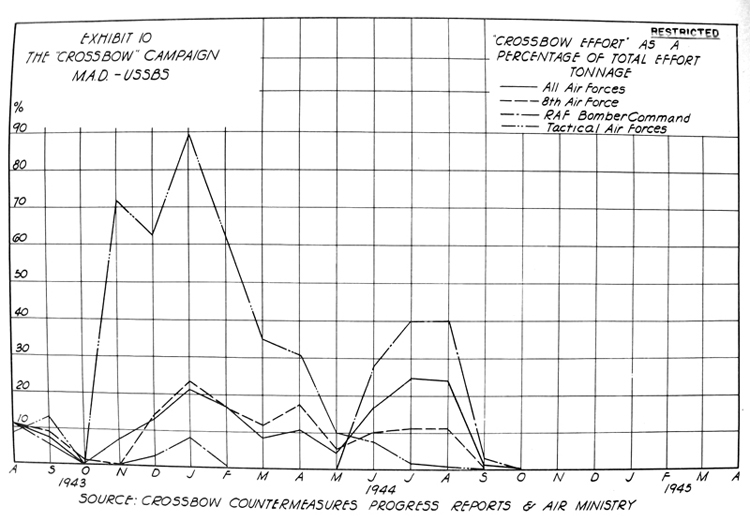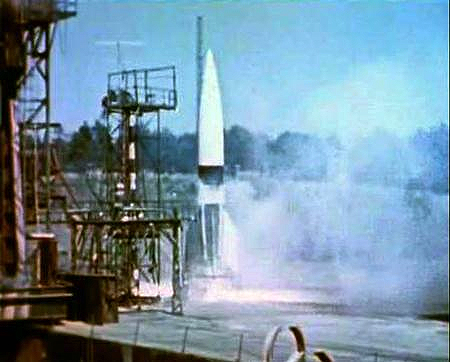V-Weapons Crossbow Campaign (original) (raw)
V-WEAPONS (CROSSBOW) CAMPAIGN
The United States Strategic Bombing Survey
FOREWORD
1. The code word "Crossbow" was used throughout the period of planning and operations as a convenient term for any matters relating to the attack on England by long range weapons, including all counter-measures against such attacks. It is used in the same sense in this paper, although after D-day the term included attacks against continental targets as well.
2. This report does not attempt to be a complete account of the development and exploitation of "secret weapons" by Germany, nor a detailed and final appraisal of the success or failure of the counter-measures employed against them. Several competent agencies are engaged in research along these lines and their findings will be available in due course. This report attempts rather to consider the "Crossbow" campaign as an influence on the operational pattern of the Strategic Air Forces.
3. Considerable background material has been included to place in better perspective a subject which has been clouded by secrecy and distorted by propaganda. At the time of writing, documentary evidence on many important details of German planning was lacking and the individuals who might have provided these details had not been apprehended. In the interim, intelligence sources were drawn upon to the extent deemed necessary. Any conclusions based thereon will be subject to revision.
SUMMARY
1. After many months of experiment and preparation the Germans finally began the use of long range weapons against England in June 1944. In the next 10 months more than 8,600 missiles reached or approached England, of which 7,500 (87 per cent) were V-1s or pilotless aircraft, and the remainder V-2s or long range rockets. Although some were aimed at other targets, limited accuracy at extreme range made them effective only against a target the size of London. Between September 1944 and the end of the war about 8,200 missiles, of which about 30 per cent were V-ls, were reported against continental targets (chiefly Antwerp.)
2. Allied offensive countermeasures began nearly a year before the first attack, increasing in weight and frequency until the late summer of 1944, when they suddenly dropped to insignificant proportions. Countermeasures consisted chiefly of bombing attacks on several" types of launching sites, a number of storage depots and other categories of targets. They were intended to delay the beginning of attacks and to limit their intensity once begun.
3. No documents giving precise data on overall German plans have been located, and available interviews are singularly unsatisfactory in this reject. However, with regard to V-ls, it appears:
a. that planned operational capabilities were greater than planned production;
b. that actual production never approached the planned figure of 6,000 per month; and
c. only for s period of seven weeks in June and July 1944 did the actual rate of fire approach 3,000 per month.
4. Plans for V-2 launching were originally on a grand scale, but by the end of 1943 had been reduced to 2 more realistic figure of 30 per day. Production seems to have been planned on comparable lines and reached nearly 800 per month in the spring of 1945. The actual rate of fire reached a maximum of 26 per day and 130 per week, excluding abortive shots which were estimated at 10 per cent.
5. There is good evidence that countermeasures delayed the beginning of V-l attacks by three months or more, but after attacks had begun, bombing had little effect. Delay in the beginning of V-2
attars amounted to approximately six months. Factors contributing to this delay were (in order of occurrence):
a. Bombing of the experimental establishment at Peenemunde on the Baltic.
b. Technical difficulties with the weapon.
c. Bombing of factories at Wiener-Neustadt and Friedrichshafen.
d. Bombing of launching sites at Watten and Wizernes on the French coast.
Some of these factors were potential, as far as the actual delay was concerned, and were not cumulative, except possibly (a) and (b). The technical difficulties held up manufacture to such an extent that time was available to reorganize production plans, and the French launching area was overrun before the bombing of Watten and Wizernes could affect actual operations.
6. The construction of a fortified firing site for a long range gun battery was seriously impeded by bombing, and the installation was captured before completion.
7. During the period of counterattacks the Germans developed methods of launching V-ls and V-2s from small and inconspicuous sites which required very little engineering work and made firing operations
independent of the elaborate sites first planned. No parallel development occurred in the long range gun.
8. The Strategic Air Forces based in England dispatched 36,795 aircraft on offensive counterattacks and dropped 102,491 long tons of bombs, representing 5.6 per cent and 6.8 per cent of their total
bombing effort. During a 13 month period, from August 1943 to August 1944, the joint effort absorbed 13.7 per cent of their bombing sorties and 15.5 per cent of their bomb tonnage. The Tactical Air Forces were also heavily involved during the autumn and winter of 1943. Nearly all of this effort was applied against launching sites and the supply organization in northern France. The reconnaissance effort was likewise substantial; 4,000 sorties or 40 per cent of those flown from the United Kingdom in a 23 month period (from May 1943 to April 1945) contributed to the "Crossbow" campaign.
9. A variety of factors, chiefly weather, the geographical locations of the targets and skillful planning made the actual diversion of effort from other target systems of high priority very much less than the operational statistics appear to indicate. In the case of the Eighth AF, on only two days between 1 December 1943 and 1 September 1944 was there any substantial diversion from visual attacks on German targets.
10. Although there is no evidence that bombing caused a decrease in output, failure to meet planned production schedules for V-l is attributable partly to the direct effects of attacks on known or suspected manufacturing plants, partly to the bombing of plants whose connection wa3 unknown at the time, and partly to the gradual disintegration of German industry and transport which led to shortage of materials and delays in deliveries.
Table 1. COMPARISON OF PLANS AND ACCOMPLISHMENTS
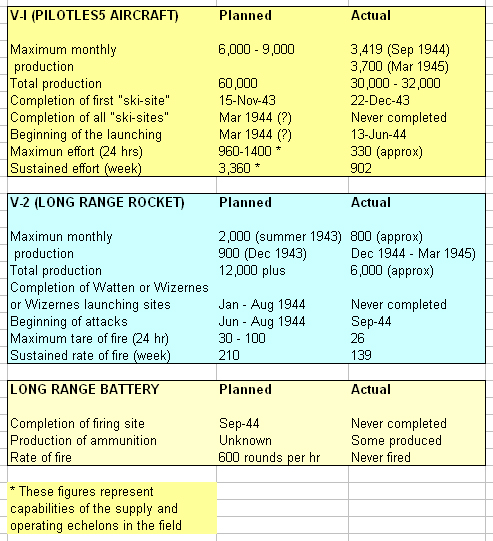
HISTORICAL REVIEW
1. Peenemunde. The intention of the Germans to develop and use "secret" weapons was rumored from the very beginning of the war such rumors being continuously fostered and exploited by their propaganda
to confuse the Allies and bolster morale on the home front. In 1942 and 1943, however, it became evident that experiments with long range weapons were being conducted on the shores of the Baltic, centering about the large experimental and research establishment at Peenemunde. There the V-l (flying bomb or pilotless aircraft) and the V-2 (A-4 long range rocket) were developed and tested. A variety of other weapons, fuels and propellants were also in process of evolution. These activities were amply confirmed by photo-reconnaissance.
a. Peenemunde was attacked by the RAF in August 1943, but the damage was inflicted too late to interfere seriously with the development of V-l. At most, the V-2 program may have been delayed two months. Considerable dispersal immediately took place, however, to Jesau, Anklam, Rugen, Niedersachswerfen and other localities, and it is quite probable that more serious interruptions were caused in the work on other weapons.
2. Preparations in France. During the summer of 1943 extensive tunneling and other constructional activities were observed in a number of localities in the Pas de Calais and the Cherbourg Peninsula,
south of the English Channel. Obviously not coastal defenses, these workings, which were named "large sites", were believed to be launching sites for long range missiles, designed to be invulnerable to bombing attacks. The construction at Watten, which was begun in May 1943 as a V-2 launching site was redesigned as a plant for making liquid oxygen, a rocket fuel, after being seriously damaged. (References 1 and 16)
a. Watten was attacked in August and September 1943 and work was observed to cease for several weeks. Construction of several other "large sites" continued and, as it progressed, they were attacked with varying success until July 1944. None of the "large sites" was ever used.
3. "Ski-sites". In the meantime, several smaller workings had been photographed in the same general area but their exact purpose was not immediately apparent. "These were later called "ski-sites" because of the curious shape of certain buildings. In the first week of November 1943, several important reconnaissance sorties were flown. Remarkably skillful interpretation of these photographs revealed that at least 31 "ski-sites" were being rapidly built. Within a month further reconnaissance in the Peenemunde area confirmed the suspicion that the “ski-sites" were to be used for launching pilotless aircraft. The purpose of the sites thus became apparent and the main target, London, was obvious from the orientation of the great majority of the launching ramps.
a. An analysis of the rate of construction showed that at least 20 "ski-sites" would be structurally complete by 1 January 1944. It was then decided that, direct countermeasures were necessary and a
series of bombing attacks was launched. These attacks resulted in the eventual abandonment of the "ski-sites", of which 96 had been identified by 22 January 1944. Not more than two of these were ever used operationally.
b. It appeared that the Germans had seriously underestimated the competence of our photo-intelligence and the potential accuracy and weight of our bombing attacks, for the "ski-sites" had not been designed to be bomb-proof, but were of elaborate blast-resistant construction, reliance having been placed on skillful siting and camouflage to avoid detection.
4. "Modified sites". After a period of comparative inactivity during which attempts to repair some of the damaged "ski-sites" (and to complete those not yet attacked) were nullified by bombing, a new
type of launching site was photographed on 26 April 1944, very much simplified and exceedingly well camouflaged. These sites, a large number of which were constructed with great rapidity, required a minimum of permanent construction, many buildings being prefabricated. They were referred to as "modified sites," More than 60 had been identified before 12 June 1944.
5. V-l attacks
a. First phase. A few V-ls were launched from France on the night of 12/13 June 1944, and launchings were begun on a much larger seals a few days later. These attacks against England continued until September, when the launching sites were captured. They reached their peak in the first week of July. During this period the "modified sites" were heavily bombed without marked effect on the scale of effort The supply organization was also attacked with somewhat better success, "supply sites" and underground storage depots for fuel and flying bombs providing targets. Sporadic attacks against factories and hydrogen peroxide plants were also made, and the bombing of railway targets in northeastern France and Belgium contributed to the difficulties of the German supply. (Reference 2). The defenses against the flying bombs themselves, fighter patrols, anti-aircraft guns and balloons, organized before launchings commenced, reached a high degree of efficiency and destroyed a progressively greater proportion of V-ls before they reached the London area.
b. Second phase. In the middle of September 1944, a second aeries of V-l attacks on England began and continued on a small scale until mid—January, with missiles launched from aircraft over the
North Sea. (A few air launchings began in July and are included in the "First Phase").
c. Third phase. A much heavier V-l campaign against continental targets (chiefly Antwerp) was begun in October 1944 and continued until March 1945.
d. Fourth phase. The final phase of V-l operations commenced just before the German collapse when a small number of longer range flying bombs were directed against England from bases in Holland.
6. V-2 attacks. Concurrently with the first phase of V-l activity, bombing attacks designed to delay and impede the launching of rockets (V-2) were continued. The "large sites" at Watten and
Wizernes were neutralized, supply depots were attacked and a campaign was launched against liquid oxygen plants and electric power and transformer stations. These attacks succeeded in that no rockets were launched against England from France, but it is probable that an adequate supply of weapons would not have been ready in any case before August or September 1944, by which time northern France was already in our hands. V-2 launchings against England from bases in
Holland and against continental targets from Holland and western Germany finally began in the first week of September and continued until late March 1945.
7. Reduction of bombing effort. With the cessation of launchings from France, the Allied bombing effort against V-weapons fell off very sharply in September 1944 and was not resumed. The firing sites for V-2s were small, well camouflaged and did not make rood targets for bombers. The air launchings of V-ls were not on any great scale, and it was felt that our forces could be better employed than in attacking the "modified sites" used for V-ls against continental targets. During
this period our only offensive countermeasures consisted of a few attacks on airfields associated with air-launched V-ls and patrols and attacks by fighter aircraft against rocket firing sites and transportation facilities serving them. However, the progressive disorganization of the German economy, the shortage of motor fuel and dislocation of transportation caused by air attack, and the loss by capture of industrial plants and sources of raw materials, had their effect on the V-weapon campaign just as on every other form of German military enterprise.
a. Exhibit 1 shows graphically, against a time scale, the main phases and comparative weight of V-weapon attacks and their relationship to the offensive counter-measures.
GERMAN FLAWS AND ACCOMPLISHMENTS
1. General plans. There is no evidence that the V-weapons used against England were originally evolved for a concerted effort with a variety of weapons. On the contrary, they were developed separately, over quite different periods of time, and promoted by different organizations. In this their history is in no way abnormal. However, after the Battle of Britain and the failure of Germany to attempt an invasion of England, their "long range" characteristics automatically placed
them in the same category and it is reasonable to suppose that a concerted use of all devices hiving this capability should have been planned. The construction of launching sites for the different weapons furnishes circumstantial evidence that simultaneous attacks on London by V-ls, V-2s and long range guns (firing salvoes of 25 or more projectiles) were, in fact, contemplated, V-l and V-2 were [ait under the same operational control in October 1943. (Reference 16). Unfortunately, documentary evidence of the planning of such a campaign, and setting forth the proposed datas and figures, has not come to light and we ar« forced to build up this capability from its component parts. That the V-l attack was to be reinforced by conventional bombing has been testified to. (Reference 3).
2. Plans for V-l
a. Production, The development of the pilotless aircraft (V-l) proceeded much more quickly than that of the A-4 rocket (/-2). Speer states that it was designed by Fieseler of Kassel late in 1942. Tests had been largely completed by August or September 1943. Series production at the rate of 6,000 per month was apparently planned (although Hitler in September 1944 ordered "capacity" to remain at 9,O00). (Reference 4J). The original program called for 60,000, which figure was later reduced to 51,000. (Reference 5). Component production was to b» well dispersed. Final assembly was planned for at least two conventional factories, Volkswagenwerke at Fallersleben and Bruns Werke at Stettin. Assembly was also planned (as of December 1943) at several GAF munitions establishments (Luft-Munitions-Anstalte a.b.v.) in Germany. (Reference 6). Underground assembly at Niedersachswerfen was not part of the original plan.
b. Launching sites. Construction of "ski-sites" began in September 1943. The date fixed for the completion of the first sites was 15 November 1943. (Reference 7). Before counterattacks began it
was estimated from examination of photographs that on 2 December 1943, 26 "ski-sites" were 50 per cent structurally complete and that a full' scale attack might be launched in February or a smaller attack during January. The following table gives an estimate of the number of "ski-sites" which would have been completed by certain dates, assuming unmolested construction. ("Modified sites" were not a part of the original plan.) (Exhibit 5).
1 January 1944 20[*]
29 January 1944 54
19 February 1944 88
5 March 1944 92
[*]These figures are based on weekly "Crossbow" countermeasure reports and assume that an additional six weeks would be required after sites were 50 per cent complete.
Construction of the "bomb-proof" launching sites at "Siracourt", "Scottevast", "Martinvast" and other places on the channel coast began between July and September 1943. (Reference 13). It is doubtful whether their construction could have been completed in less than a year, although frequent bombings have rendered estimates of this sort very difficult, and no documentary evidence is available.
c. Supply. Two large storage depots for V-ls were located in caves at Nucourt and St. Leu d'Esserent and a third was near Rheims. Several "supply sites" were begun at about the same time as the "ski-sites". They were approaching completion early in June when they were first bombed. Their exact function in maintaining the planned scale of effort is not known.
3. Potential rate of fire. The maximum rate of fire of a "ski-site", as estimated by our intelligence, was 20 per 24 hours. (Reference 8). Against this we have evidence that a good crew could fire one V-l every half hour (Reference 3) and that a maximum of 18 during one night was actually achieved. The highest rate which could be maintained over a period was 15 per site per day. This would give a maximum effort of 960 for one regiment (16 troops of four crews each). Assuming that 50 per cent of this effort could be sustained, one regiment could fire about 3,360 V-ls per week (more than twice the planned rate of production), given sufficient sites and adequate sup¬plies of missiles and fuel. From the same interrogation (Reference 3) it appears that only 64 "ski-sites" were originally planned, 56 in the Pas de Calais and eight in the Cherbourg area. Another 32 sites, "originally planned as dummies", were later "built as real sites". This total of 96 thus checks with the number of "ski-sites" identified on photographs.
a. The same document states that 10 "fortified sites" were planned. The party which surveyed some of these sites (Reference 1) estimated them to have a firing capability of two missiles per hour. This yields a total of 480 per day or (at 50 per cent), 1,680 per week. The planned activation of another firing regiment has been mentioned by several PWs. However, if this regiment was to operate the fortified or "large sites" it would not have been required before the summer of 1944, and long before that time it was evident that supplies of missiles were inadequate and the launching sites themselves not invulnerable. This seems an adequate explanation for the fact that the second regiment was never activated.
3. Plans for V-2
a. Development and production. The development of long range rockets by German scientists began between 1920 and 1930, allegedly for commercial exploitation. The military application, however, was quickly realized and after 1932 research and experiments were vigorously pushed.
The technical difficulties of launching and control had been mastered by July 1943, and mass production of V-2s was ordered to begin. (Reference 4 D & E). After about 1,000 had been built, it was discovered that there was a high percentage of air bursts and structural failures. In June 1944 production was reduced pending further experiments and was not resumed on a large scale until September 1944. At the end of 1944, production reached a rate of 800 per month, and a total of more than 6,OOO V-2s had been manufactured by the end of the war. Of these, approximately "3,000 were possibly used for tests. (Reference 9). The maximum rate of production planned in the summer of 1943 was 2,000 per month, but this figure was reduced to 900 in December (Reference 10 and 16).
b. Launching. The first concrete figure on planned launchings occurs in March 1942, when Hitler fixed sufficient fuel for 3,000 launchings per month as a deciding factor in the V-2 program. (Reference 4A). In October 1942, he stated that V-2 would be ineffective unless
5,000 could be launched simultaneously.
c. Lt. Gen. Dornberger, in charge of V-2 development at Peeneraunde, (Reference 16) states that "to start the operation" there were to be three firing units (abteilungen), one fixed and two motorized.
Each motorized unit would fire 27 rockets daily and the fixed unit "twice that many" - a total of 108 daily. Speer (Reference 12A) gives launching plans as 80 to 100 daily. These are fairly early plans and conform reasonably well to Hitler's figure of 3,000 per month. A report
(Reference 11) on the supply organization for the French launching sites states that the "target" was to launch 30 rockets per day, and provides an estimate of the sustained effort envisaged in January 1944. This program, however, was for dispersed launching sites and did not include
the "large site" at Wizernes, which alone would have been capable of assembling and launching 50 to 90 rockets in 24 hours had it been completed. (Reference 1).
d. Time. Watten, the assembly and launching site first planned, was begun in May 1943, and could have been completed in about a year if unmolested. However, it was seriously damaged in August
1943 (Reference 16) and the construction of a second site, Wizernes, was begun. This extensive underground storage depot, final assembly plant and launching point, the vital parts of which were protected by a huge concrete dome, made rapid progress during the fall and early winter of 1943. Thereafter, it was so heavily and continually attacked that any accurate date for completion cannot be estimated. It is unlikely that it could have been completed before September. Preliminary
work on the selection and construction of dispersed V-2 firing sites was begun in January 1944, but this fact gives little information on the planned date for beginning operations, (Reference 3).
e. Readiness of supply organization., A small supply organization which had been in existence previously was found inadequate to cope with the accelerated program of late 1943. It was enlarged and additional officers were trained in November of that year. The building organization was enlarged somewhat later. Eight main storage dumps were planned and four had been completed by July 1944. At least two more were under construction. One, at Mery-sur-Oise, was begun in August
1943. Construction was completed by February, 1944 and it was ready to operate in June 1944. It had a normal capacity of 600 rockets. (Total normal capacity, four dumps, July 1944, 4 x 600 = 2,400; emergency, 4 x 800 = 3,200). Four forward depots each with a capacity of 80 rockets were completed by January 1944. In addition 120 unloading sites were surveyed and several transit dumps were made ready. Moreover, alternative supply routes independent of rail transport were completely worked out. Units of the supply echelons arrived in France in January 1944 and finally withdrew in August. A repair unit also withdrew after a brief appearance in June 1944. The "technical personnel" never came to France. No rockets were ever transported to France (Reference 11), although fully trained firing units were available in May. (Reference 16).
f. Potential rate of fire. It thus appears that except for unforeseen defects in the weapon itself, the launching of rockets against England from France could have been begun in June 1944 at a sustained rate of fire of 200 to 350 rockets per week, or a possible maximum of 100 per day, and was planned to begin at about that time had no bombing of Peenemunde, Watten, Wizerns or of the supply system occurred.
4. Total planned firepower. From the foregoing data and our knowledge of the progress of construction work in France four possibilities emerge for V-l:
a. First: affective Allied counter-measures against exposed positions were foreseen at an early date and the whole V-weapon campaign was to be conducted from the invulnerable "large site”n involving simultaneous use of three weapons. In this case, the attack could not begin before mid-summer of 1944, allowing 12 months for construction. The "ski-sites" were then built as an afterthought to take advantage of the rapid development of V-l and to permit an earlier beginning of the attack. This view is supported by the fact that construction of "large sites" began first. It also agrees with Speer'a testimony that the "large sites" were prepared to launch the entire production."
b. Second; Successful attacks on "ski-sites" were foreseen as a distinct possibility and the "large sites" were built to assure continuity of attacks using the same firing organizations. This view
is supported by the fact that the theoretical firing capabilities of one regiment was greater than the planned weapon production.
c. Third; Successful countermeasures were not foreseen. The "ski-sites" were to be manned by one Flak Regiment and the "large sites" by a second, to be activated when the latter were completed,
thus increasing the volume of fire. This would require a stepping up of production, but the use of "large sites" would simplify supply and technical problems and permit continuous firing.
d. A fourth explanation Tor simultaneous construction of "ski-sites" and "large sites" is that there was to have been an improvement in the weapon or its control involving, possibly, a more
sensitive explosive charge which would require the launching site to be "invulnerable”.
These possibilities, summarized, give the following potential firepower for March and April, 1944.
Maximum Planned Firepower of launching Sites
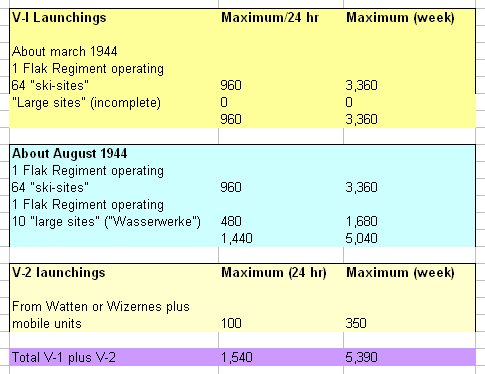
5. Long range guns. In addition to the V-l and V-2 attacks, bombardment of London by super—long range guns was also planned, and construction of a firing site was begun in 1943 and continued actively (although part was abandoned) until it was captured. The planned rate of fire of the original installation was estimated at 10 rounds per minute, or 600 rounds per hour. (Reference 1).
6. Production probabilities. The figures given above, especially for V-l, may seem fantastic when compared with the results actually achieved. However, we have abundant evidence that the Germans were told planners in other fields, and actually achieved a rate of production of 4,20o aircraft per month in July 1944. Speer, Koller and Frydag have stated (Reference 12) that production of V-l did not compete with that of aircraft and that the production cost was only a fraction of the cost of a single-engine fighter. The production of sufficient weapons to assure the weekly rate of fire given above was, therefore, well within the capacity of industry. Messerschmitt said that he believed a monthly production of 100,000 was possible.
7. Accomplishments
a. Production The volume of production planned for V-l and V-2 was never achieved. Reports on monthly output are conflicting and unreliable (References 9 and 15). It seems, however, that the monthly output of V-ls reached a maximum of from 3,000 to 4,000, but not before the autumn of 1944. For V-2s, the target figure of 900 per month was within striking distance when an average output of 700 to 800 was attained in the four months ending with March 1945, a year or more after the planned date for full scale production. By this time, transport had become a limiting factor.
b. V-l effort. The following tables (*) show the approximate scale of effort directed against England and continental targets:
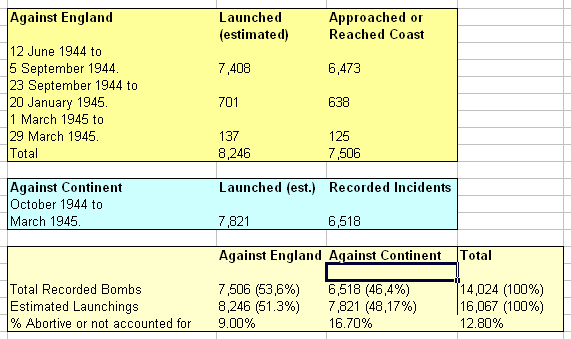
(*) Figures compiled by A.I.3.e., from reports of Air Warfare Analysis Service and SHAEF weekly estimates. The higher percentage of bombs not accounted for against continental targets is a reflection of the difficulty of identifying all incidents.
The maximum effort against England occurred in the week ending 8 July 1944 when approximately 902 bombs were launched, of which 820 approached or crossed the English coast. Against continental targets, the maximum effort was between February 19 and 26, 1945, when 586 incidents were recorded, estimated launchings being 704.
c. V-2 effort. The V-2 effort against England and continental targets was as follows:
Reached U.K. 1,115
Continental Targets 1,675
Total 2,790
In England, London was the target for all but a small percentage of the effort, while on the continent 88 percent of the rockets were aimed at Antwerp. The maximum weekly effort occurred in the first week of January 1945, when 130 incidents were reported, 59 in the UK and 80 on the Continent. Against a single target, the maximum weekly effort was 107, which was attained on two occasions against continental targets. The greatest recorded daily effort was 26, on 23 and 26 December 1944, against Antwerp.
d. Results. It is not within the scope of this paper to analyze in detail the results achieved by the Germans. The attacks on England caused widespread damage, many casualties, and a considerable reduction of industrial efficiency. (See report on V-weapons prepared by Physical Damage Division, USSBS.) They had, however, little or no military effect. On the continent the attacks on Antwerp v/ere more concentrated and, because of the shorter range, more accurate than those on London. No detailed figures are at hand, but the effects were more severe. In addition, the weight and persistency of the attacks retarded the clearing of the port and the unloading of supplies and slightly diminished the usefulness of Antwerp to our armies.
COUNTERMEASURES
N.B. Except where otherwise noted, the operational statistics used in this report have been obtained from "Crossbow". Countermeasures Reports and other Air Ministry sources. They are believed to be more reliable than the machine record statistics because, for reasons of security, many "Crossbow" targets were not designated as such when they were first attacked.
1. The countermeasures employed by the Allies against attacks by V-weapons fall into two broad classes, defensive and offensive. The first class comprised all those measures designed to minimize
the effects of flying bombs and rockets after they had been launched and included chiefly radar warning services, patrols by fighter aircraft, balloon barrages, and anti-aircraft artillery. They were particularly well organized for the defense of London, and quite effective against V-l. Against V-2, no successful defensive counter-measures were used. Defensive measures had little or no effect on the strategic bombing effort and are not given detailed consideration in this report.
2. Offensive countermeasures, on the other hand, required a major effort on the part of the Strategic and Tactical Air Forces based in the United Kingdom. Bombing and strafing attacks were made on a wide variety of targets with the object of delaying (or preventing, if possible) the beginning of launching operations and of decreasing the weight of attack which could be delivered in a short interval. These commitments involved the dispatch of nearly 69,000 sorties and the dropping
of more than 120,000 tons of bombs.
3. Another activity which should not be overlooked is the part played in the campaign by photo—reconnaissance and interpretation. Approximately 4,000 reconnaissance sorties flown by British and American aircraft contributed directly to "Crossbow" intelligence. Brilliant interpretation of the photographs obtained confirmed the reports of experimental work on the Baltic, pin-pointed and identified launching and supply sites in France, definitely established the purpose of the "ski-sites", provided the material for the targeting of more than 300 objectives, analyzed the results of attacks and, in general, provided the framework for the planning and execution of
offensive countermeasures. In all, 4,070 interpretation reports were issued on these subjects (Reference 13).
4. Phases of the campaign. For convenience, offensive counter-measures may be considered in the following four phases:
a. 17/18 August 1943. This was the initial attack on Peenemunde by the RAF.
b. 27 August 1943 to 11 June 1944. During the first few months of this period several attacks were made on the "large sites" in France. From December onward "ski-sites" were heavily bombed and
the attacks against "large sites" continued.
c. 12 June 1944 to 3 September 1944. This was the period of V-l attacks against England from France. In these months "modified sites", 3upply dumps, "supply sites" and "large sites" received most
attention, with a variety of other targets also being attacked.
d. 4 September 1944 to 3 April 1945. During this period both V-ls and V-2s were used against continental targets and V-2s against England. V-l attacks were resumed against England, first by air launchings and finally from Dutch bases.
5. In the first three periods heavy and medium bombers of the Eighth Air Force, RAF, Ninth Air Force (including Eighth Air Support Command) and the 2nd TAF were called upon for the greatest part of
the effort, the Tactical Air Forces being employed chiefly in the second period. Exhibit J shows the distribution of this effort by forties dispatched and by tons against different types of targets.
6. In the last period, the heavy bombers played a minor part, dispatching only 579 sorties and dropping 703 long tons of bombs, chiefly on airfields associated with the air launching of flying
bombs. Fighters and fighter-bombers were much more active. In all 10,270 sorties were dispatched and 1,853 tons dropped during this period. Operations included the following:
Fighter and Bomber attacks on:
a. Rocket storage and launching areas, offices, billets, etc.
b. Liquid oxygen plants.
c. Airfields associated with air-launched flying bombs.
d. Flying bomb launching sites.
e. Communications.
Armed reconnaissance.
Intruder attacks on airfields.
Defensive patrols against air-launchings.
7. Priorities. Before November 1943 no comprehensive plan for the conduct of countermeasures existed and attacks were ordered on an ad hoc basis. In November, however, attacks on launching sites
were placed on high priority for the Tactical Air Forces. On 15 December operations against "ski-sites" by the Eighth AF were for a short period given over-riding priority when suitable weather existed in Northern France. Several sites had also been assigned to RAF Bomber Command for experimental night attacks. In the last week of January 1944, Bomber Command was relieved of this commitment (except for one site) and the Eighth AF was requested to attack Watten and Siracourt when circumstances did not permit strategic bombing in Germany.
From this time on the priority of "Crossbow" operations by the several Air Forces varied with respect to their other commitments and presents a rather confusing picture. In general, the efforts of the Tactical Air Forces were gradually absorbed by preparations for the invasion, while at least part of the strength of the Eighth AF remained committed to this task. It was strongly reinforced by RAF Bomber Command after V-l attacks began.
a. Among the "Crossbow" targets, the "large sites" remained on top priority followed by "ski-sites" until firing began on 13 June 1944, subject, of course, to suspension of specific targets as a result of damage sustained. After firing began the "supply sites" and "modified sites" were placed in first and second position respectively. Exhibit 3 shows the relative priorities accorded the several types of "Crossbow" targets from 7 June to 22 August 1944.
8. Allocation of effort. All available air forces were called upon at various times in the campaign. From August to October 1943 RAF Bomber Command and Eighth AF participated, while from November
1943 to May 1944 the Eighth AF and Tactical Air Forces undertook the chief commitments. During the summer of 1944 the RAF and the Eighth AF were involved, assisted on a few occasions by the Fifteenth AF.
After September 1944 the major effort was by RAF Fighter Command, assisted by the 2nd TAF. Exhibit 4 shows the total effort by the several air forces in sorties dispatched and tons of bombs dropped.
9. "Ski-sites." In all, 96 "ski-sites" were attacked by Allied aircraft over a period of six months. Although repairs were undertaken, their threat was successfully neutralized. Exhibit E shows
the cumulative number of "ski-sites" identified weekly and the number which sustained "category A" damage[*]. (N.B. Attacks on these sites were not authorized until they were more than 50 per cent complete).
[*] This category required damage to certain "essential structures" and was deemed sufficient to prevent any launchings without major repairs.
10. "Modified Sites". Attacks on "modified sites" did not begin until launching of V-ls had commenced. Exhibit 6 shows similar graphs for the identification and neutralization of these targets. The "modified sites" were more quickly built, better camouflaged and more difficult to identify than "ski-sites". They were first subjected to bombing and later to harassing attacks*
11. "Supply sites". Seven specialized "supply sites" for V-ls were attacked. Three were severely damaged and the others, though not so seriously affected, were apparently abandoned.
12. "Large sites." The sinister "large sites" were repeatedly attacked from August 1943 to July 1944. Martinvast was abandoned at an early stage. Half of the installation for long range guns at Marquise/Minoyecques was likewise abandoned. At the remaining five sites construction work was disrupted and delayed by frequent attacks, but progressed under increasingly difficult conditions. The use of 12,000 lb "Tallboy" bombs by RAF Bomber Command in June and July 1944 produced more tangible results, causing severe damage to the heavy concrete structures of Watten, Wizernes, Siracourt and Minoyecques.
13. "Storage dumps." for rockets and flying bombs located in caves and tunnels at Nucourt, St. Leu d'Esserent, Thiverny, Mery-sur-Oise and Rilly-la-Montagne and in several wooded areas were subjected
to a number of attacks. Those on Nucourt ware the most successful, a sharp drop in V-l fire occurring after the attack of 6 July 1944. At this dump, which was in use for storage of flying bombs, there were considerable areas of collapse, and activities were transferred to St. Leu. Detailed information of the effects of other attacks on supply operations was not available.
14. Targets in Germany. A number of attacks were made on industrial and experimental targets in Germany in an attempt to interfere with the production of V-weapons and of hydrogen peroxide. The targets attacked included the following:
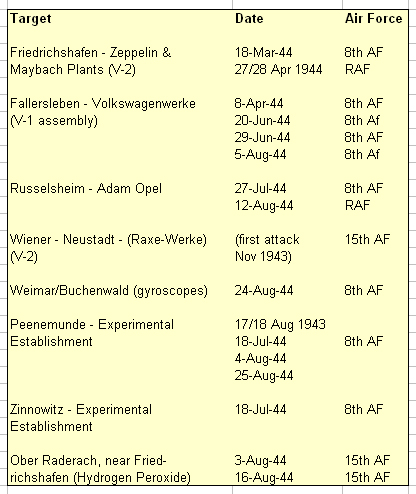
The physical damage sustained by these targets was great, particularly at Friedrichshafen, Fallersleben, Russelsheim and Buchenwald. (See USSBS Munitions Division report on Fallersleben). The effect of these attacks was very difficult to assess. At Fallersleben, a comparatively small part of the huge plant was engaged in V-l production and this section escaped very serious damage. It was apparently possible to continue production at Fallersleben and at the company's other plant at Schonebeck. Because of dispersed production facilities and lack of detailed data it wa3 not possible to trace the effects of bombing on other industrial plants. At Peenemunde, two leading scientists were killed in the first attack, with consequent delays in development of V-2, and plans for large scale assembly there were abandoned0 While the 1944 attacks had little or no effect on V-l and V-2 they did interrupt experimental work on the large anti-aircraft rocket "Wasserfall" (Reference 18). This weapon was the chief competitor of the offensive V-2, and its prior development had been strongly urged by those who maintained that offensive attacks against England would be futile as long as the Allies had air superiority in Germany (Reference 19)
15. Other targets attacked included fuel dumps, electric power and transformer stations, liquid oxygen plants, airfields, etc. Most of these attacks were made such & short time before the capture of the French launching areas that their results were inconclusive. Against rocket firing from Holland, attacks on rail targets by Mosquitos and fighter bombers appear to have had a greater disrupting effect than attacks against launching sites and forward rocket storage dumps.
16. Indirect attacks. It must be remembered that the production, transport and storage of V-weapons wa3 carefully planned by the Germans to avoid vulnerable bottle-necks. The manufacture of components was widely dispersed. The assembly, of V-ls and V-2s, begun above ground, was soon transferred below. Supply and storage dumps were very largely underground. Transport of weapons was accomplished mostly at night and always carefully camouflaged. Under these circumstances, the few attacks made on industrial plants because of their "Crossbow" con¬nections were less effective in limiting production and supply than many attacks directed primarily against other target systems. The following instances are cited as examples:
a. V-2 Production: Herr Figge, Director of the Supply Committee for V-2s, (Reference 10) stated that production was to reach 900 per month by December 1943, but that this figure was never reached.
"This was due, chiefly, to the non-delivery, of electrical instruments and other materials, through lack of supplies or as a result of air raids." This production was equally divided among three plants, Peenemunde (Heeres-Versachs-Anstalt), Wiener-Neustadt (Raxs-Werke) and Friedrichshafen (Luftschiffbau Zeppelin) but "as all three had been partly destroyed in air raids, and it was no longer feasible to carry on production there, the whole A-h production was given to the underground factory Mittelwerke GmbH." Wiener-Neustadt and Friedrichshafen, two of the three places named, were first attacked because of their connection with the aircraft industry.
b. V-l production: Fallersleben also was first attacked because of its association with repairs to Junkers aircraft, although its known production of military vehicles and weapons increased its
target value. Although there is some evidence that V-l production continued there after the attacks in June 1944 (see Munitions Division Report), it is not stated how much of this production actually took place at the bombed plant and how much at the dispersed factory at
Schonebeck.
17. Considering offensive countermeasures as a whole, the attacks on "ski-sites" were the most effective measures against V-ls. They forced the re-planning of the entire launching procedure and the design and construction of an entirely new system of sites. The exact delay entailed is not yet known but available evidence indicates a maximum delay of three or four months. Once launching of V-ls had begun, very little effect of bombing can be traced, except for a sharp drop in firing caused by a heavy attack on the storage dump at Nucourt. It is evident that the volume of fire was not up to German expectations. The following factors contributed:
a. Shortage of weapons (production)
b. Bombing and harassing of launching sites
c. Bombing of supply sites and dumps
d. Interference with transport
e. Failure to complete "large sites"
18. Delay in beginning V-2 launchings appears to have been the result of defects in the weapon itself, discovered at a late stage in development. There is no positive evidence that bombing of Peenemunde contributed directly to this delay. Dornberger, however, stated categorically that the first attack caused a delay of at least two months in the "rocket apparatus" (Reference 16). While these defects were being corrected, further experiments reduced the time required for launching each rocket and made such structures as Wizernes unnecessary. Bombing of Watten, Wizernes and the rocket storage depots, therefore, had no direct results, but must be viewed as precautionary measures. After firing had begun, attacks on rail transport were the only measures which materially affected the scale of attack.
COSTS
1. The cost of the V-weapon campaign to both sides was very large. For lack of data no complete estimate or summary can be made at this time. However, some figures are available which will give a rough picture of the relative C03ts.
2. An Air Ministry paper (Reference 14) prepared in November 1944 and dealing with the first series of V-l attacks only and all countermeasures (offensive and defensive) estimates our own cost at
nearly four times the cost to the enemy:
Cost to us as fraction of total enemy cost (Total enemy cost taken as 1.0)
Damage and loss of production 1.46
Bombing attacks by A.E.A.F. .34
All other bombing attacks 1.54
Fighter interception .30
A.A. .09
Balloons .07
TOTAL 3.80
In addition, 7,810 Allied lives were lost, of which 1,950 were aircrew. The equivalent[*] of 498 aircraft was lost, including 399 four-engined bombers. Our total costs are given as 2,442,779 men months against 641,060 for the enemy. The three largest items of enemy cost were:
AA 200,000 man/months
"Ski-sites" 154,560 man/months
"Modified sites" 97,500 man/months
The British estimate of 1,150 man hours per V-l checks reasonably well with German statements that the cost was 1/20 of V-2 and that the latter required 20,000 man hours (at an early stage of development), and Rickhey's[**] estimate (Reference 9) of 900 man hours. The paper points out that the estimates of enemy costs were based on scanty information and that some items have beer omitted. The fol¬lowing omissions might be noted: Cost of enemy research and develop¬ment; construction of four "large rites"; cost to us of fighter escort for bombers, photo—reconnaissance, interpretation and preparation of target material.
[*] Damaged aircraft included as fractions.
[**] Dipl. Ing. Georg Rickhey, managing director of the underground factory at Niedersachswerfen.
3. For the other phases of the campaign our relative costs would be lower for the following reasons:
a. There was no sustained bombing effort against V-l launching sites after September 1944.
b. The unit cost of V-2 was as much as 20 times that of V-l.
c. The damage done per V-2 incident was not proportionate to this greater cost.
d. No lost time was caused by alerts for V-2.
4. The Sanders Mission (Reference 1) estimated that the six "large sites" in the Pas de Calais absorbed 15,000 personnel throughout the whole period of their activity (which averaged about one
year). Had they been put into operation as planned, the services rrom 100,000 to 200,000 people would have been absorbed (including production and transport of weapons).
5. The relative cost of neutralizing "ski-sites" and "modified sites" expressed in sorties dispatched, long tons of bombs dropped and aircraft lost is shown in the following tables. Note particularly the effectiveness of Mosquito attacks.
TABLE I.[*] RESULTS OF ATTACKS ON "SKI-SITES" 5 December 1943 - 11 June 1944
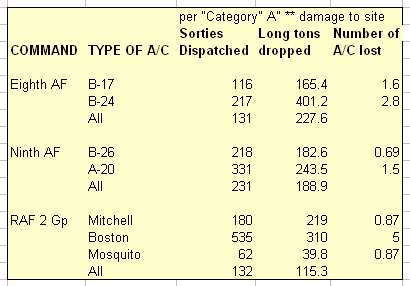
[*] Source: "Crossbow" Countermeasures Progress Reports. ** See footnote, Page 19.
TABLE II,[*] RESULTS OF ATTACKS ON "MODIFIED SITES" 12 June 1944 - 21 July 1944
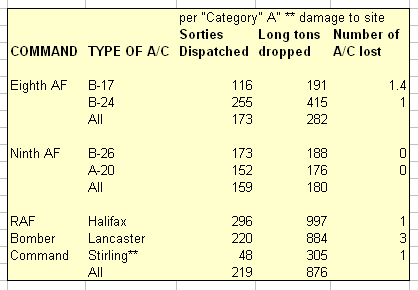
[*] Source: "Crossbow" Countermeasures Progress Reports.
[*] Small Sample.
6. The total[*] Allied offensive "Crossbow" effort from August 1943 to March 1945, inclusive, was as follows:
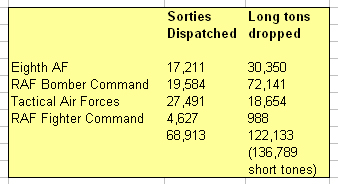
[*]Fifteenth Air Force excepted.
DIVERSION OF EFFORT
1. One of the most obvious results of the V-weapon campaign was that it caused the Allied air forces to turn aside from their primary offensive mission and commit part of their forces to essentially defensive operations. This commitment was very substantial. For the entire period of the war the figures for the two Strategic Air Forces based in England were as follows:
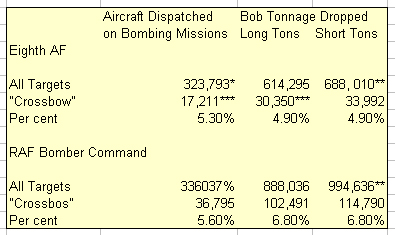
Sources:
[*]Statistical Summary of Eighth AF Operations, 10 Jun 1945
[**]DSSBS Machine Record figures, 20 Sep 1945
[***]Air Ministry Historical Section and "Crossbow" Reports
[****]Air Ministry War Room
N.B. Figures on "Crossbow" include attacks on liquid oxygen and hydrogen peroxide plants and other targets which were believed to be directly connected with the development, production or employment of V-weapons. Many of these are not included in machine record statistics for "V-weapon launching sites."
2. Nearly all of this effort wag concentrated in the 13-month period from August 1943 to August 1944. inclusive:
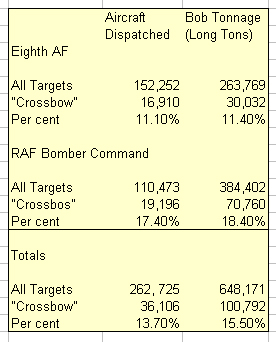
3. During this same period the Tactical Air Forces (Ninth Air Force and 2nd TAF) were also heavily committed:
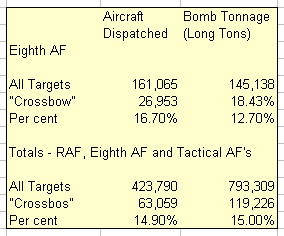
4. In the five-month period from November 1944 to March 1945, RAF Fighter Command devoted the major part of its offensive effort to "Crossbow", vis., 79 per cent of 5,865 sorties.
5. The reconnaissance effort was also substantial. Of 10,310 sorties dispatched from the United Kingdom between 1 May 1943 and 31 March 1943 about 4,000 or nearly 40 per cent were to some extent concerned with "Crossbow."
6. Distribution of effort. Exhibit 7 shows the monthly distribution of the Allied bombing effort in sorties dispatched for the period of the campaign. Exhibit 8 is a similar graph showing tonnage
of bombs. The tonnage dropped by RAF Fighter Command is too small to be significant and is not shown. Note particularly the sustained pressure which was maintained from December 1943 to May 1944 followed by an enormous increase in the tonnage in June, July and August.
While the tonnage increased from about 3,000 in May to more than 22,000 In June and over 30,000 in August, the number of sorties dlspatched was only slightly more than double - a striking illustration of the carrying capacity of the RAF heavy bombers.
7. Diversion of allied effort. Exhibits 9 and 10 show the monthly "Crossbow" effort of the several air forces expressed as a percentage of the total effort against all targets. Although this effort was quantitively great, amounting in some months to more than 25 per cent, it does not justify the conclusion that if the V-weapon threat had not existed an equivalent effort could have been exerted against other high priority target systems. The reason is obvious when the following points are considered:
a. Most of the "Crossbow" targets were not in Germany. Therefore, they could often be attacked under visual conditions when German targets were cloud covered.
b. The short distance from English bases permitted much greater flexibility in the timing of operations than was possible against German targets. For example, these targets could be attacked late in the day and on several occasions double sorties were possible.
c. The targets were always within range of medium bombers based in England. German targets were not, until late in the war.
d. The targets were within range for ground-controlled instrument bombing, at a time when German targets were not.
e. The short penetration required a minimum fighter escort and permitted a maximum bomb tonnage to be carried.
f. For the Strategic Air Forces visual attacks on targets of the Combined Bomber Offensive were always on higher priority than "Crossbow" operations, except for short periods. How some of these factors operated Is discussed in the following paragraphs.
8. Eighth AF
a. The attacks of the Eighth AF against V-weapon installations in northern France have been analyzed to determine what limitations weather conditions imposed on utilization of this force
against other targets. No attempt has been made to assess the diversion caused by attacks on "Crossbow" targets in Germany.
b. During the period 24 December 1943 through 31 August 1944 the Eighth AF dispatched bombers on 69 different days to attack targets of this classification. The "Crossbow" effort compared with
the total effort of the Eighth AF during this period is as follows:
TABLE III. Total Effort Dec 1943 - Aug 1944 Related to "Crossbow" attacks (Source of data for Tables III, IV and V - Eighth AF Statistical Summaries and Intops Reports)
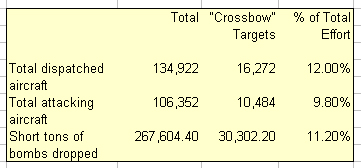
c. In appraising the diversion which the "Crossbow" attacks represented, three other types of missions have been considered.
(1) Visual missions to Germany.
(2) Blind missions to Germany.
(3) Visual missions to other targets in France and the Lo" Countries.
d. Diversion according to this scheme is shown in the following table.
TABLE IV. Diversion of Effort by "Crossbow" Attacks on Targets in Occupied Countries
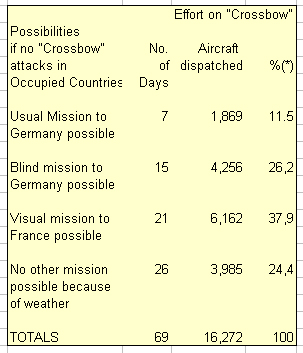
[*]Percentages relate to the total "Crossbow" effort during the period under consideration.
e. Table IV indicates that 11.5 per cent of the effort dispatched on "Crossbow" attacks could have been utilized for visual attacks against targets in Germany and 26.2 per cent for blind
attacks against Germany. Roughly, 6,100 sorties could have been dispatched against Germany, nearly 2,000 of them on visual operations. These 6,100 sorties would represent about 4.5 per cent of the total Eighth AF effort for the period analyzed.
f. Investigation of the seven days when opportunities for visual attacks on German targets were "lost" reveals that none occurred before 30 May 1944. Furthermore, on only two days were more than 108 aircraft "diverted."
TABLE V. "Crossbow" Diversions
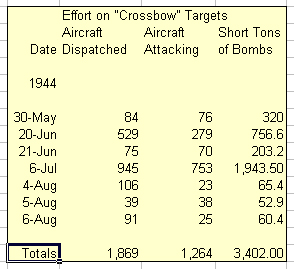
g. Further analysis shows that even on these critical days opportunities to attack German targets were by no means neglected:
Targets Attacked
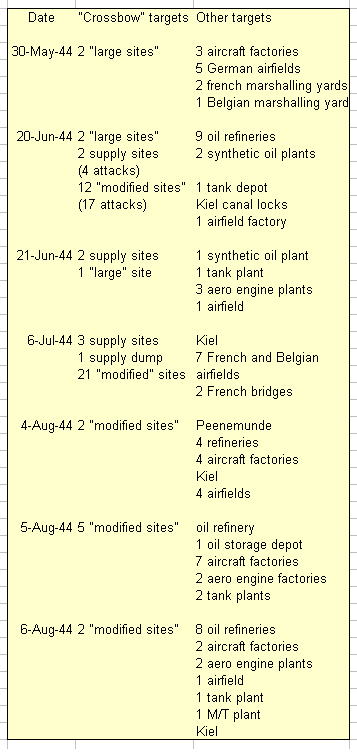
9. RAF Bomber Command. For Bomber Command the greatest diversion occurred in June, July and August 1944 after V-l launchings had begun. In the last two of these months the diversion amounted to 40 per cent of total effort. During this period, however, the RAF was still hampered in making deep penetrations by the short nights and by the German development of night fighter tactics which had proved so effective at Nurnberg at the end of March. A series of shallow daylight penetrations began with the attack on Le Hivre on 14 June but the first daylight penetration of Germany in force did not come until 27 August when Homberg was attacked. Under these circumstances it is apparent that very little of the "Crossbow" effort could have been applied to priority targets in Germany without risk of very heavy losses. Other available targets were French transport facilities and airfields which were already receiving liberal tonnages from the Tactical Air Forces and the Eighth, not to mention the RAF itself.
10. Tactical Air Forces. The greatest "Crossbow" effort of the Tactical Air Forces was made in the winter of 1943-44, reaching a maximum of 93 percent of sorties dispatched in January and falling off rapidly as D-Day approached. During this period German targets were out of range and the only available alternatives were airfields, aircraft repair factories, port facilities and other minor target systems in the Occupied Countries. Although high in percentage, the tonnage dropped was not very great and the diversion of effort was unimportant.
11. Reconnaissance. Except for its value in providing additional photo-coverage of the invasion coast, the reconnaissance effort constituted a serious loss to strategic intelligence.
12. Compensating Factors. Although "Crossbow" operations were essentially a diversion from the attack on the German war potential they did not represent a total loss to the Air Forces taking part. The searching out and bombing (chiefly by small formations) of hundreds of well concealed targets provided valuable training and experience in navigation and target identification for aircrews. Experiments were undertaken which resulted in marked improvements in blind bombing tecniques. The problem confronting intelligence led to the development of new types of target material. And finally, the necessity for having large numbers of aircraft attack many targets in a small area taught valuable lessons in tactical planning and paved the way for later coordinated efforts of the several Air Forces. Although the "Crossbow" missions increased the turnover in combat crews, the improvements in bombing techniques and operational planning which resulted were a substantial factor in achieving the marked efficiency and versatility which the Air Forces displayed in their cooperation with the Ground Forces after the invasion had begun.
13. Diversion of German effort. This report would be incomplete if no general reference were made to the diversion of the German war effort involved in the "Crossbow" campaign. This enterprise was no mere by-product of war industry nor was it an inconsequential plaything of the Wehrmacht. Over a period of years it absorbed a significant part of Germany's brains and brawn, often the most valuable part, in a vain attempt to make good the failure of the Battle of Britain and, possibly, to achieve even greater ends.
a. Research and development. In the field of research and development the abilities of hundreds of top ranking scientists and technicians were absorbed in devising and testing the V-2 rocket. Not only such government-sponsored establishments as Peenemunde were involved, but also the universities and such industrial con— corns as Siemens, Askania, Lorenz and I.G. Farbenindustrie. The implications of this preoccupation are far reaching and are illustrated by an incident at Peenemunde in the summer of 1943. There, a group of technicians which was developing the "Wasserfall" antiaircraft rocket was shifted to work on V-2. The former weapon, if perfected sooner, might have caused very severe bomber losses (Reference 18).
b. Construction. The huge quantities of labor and material lavishly used in the construction program on the French coast were very largely wasted. The monumental "large-sites" and the scores of
"ski-sites" were never used, despite dogged efforts to complete them in the face of repeated bombings. Under a different program this effort could have been readily employed to strengthen the coastal defenses, provide additional bomb-proof shelters for submarines and torpedo boats, or to undertake a variety of projects which would have paid higher dividends.
c. Underground factories. The degree of faith which the Germans placed in the V—weapon program is best illustrated by the decision to put the entire production underground. At a time when
Allied bombers were demonstrating their powers of wholesale destruction and frantic efforts were being made to house the most vital industrial processes and machinery in places safe from bombing, a large section of the most ambitious underground project, the Mittelwerke at Niedersachswerfen, was assigned, not to the production of ball bearings, crankshafts, electric motors, fighter aircraft, synthetic oil, rubber or nitrogen, but to the assembly of V-ls and V-2s.
d. Industrial capacity and critical materials. Aside from the plant capacity absorbed, the industrial effort required for the production of 30,000 V-ls and 6,000 V-2s may be conservatively estimated an equivalent to 24,000 fighter aircraft. (Assuming that one a/c equals five V-ls or one-third V-2). Although Speer and others deny any conflict between V-l and aircraft production, they admit the competition of V-2, particularly in requirements for instruments and electrical equipment (Reference 12). On the other hand, one of the reasons given for failure to fulfill production plans for V-l is a shortage of sheet metal, which is tantamount to saying that the
30,000 V-ls which were produced reduced the supplies of this commodity available to other priority projects.
3. Explosives and propellants. The warheads of V-l and V-2 each contained about one ton of explosives, a total of 36,000 tons for entire production, which is approximately equal to 50 per cent of the monthly consumption of the whole Wehrmacht in the critical months of July, August and September 1944 and equal to the total monthly explosives production of September, October and November of that year. The shortage of explosives which developed in the fall of 1944 was so acute that it was necessary to use inert rock salt, sometimes as much as 70 per cent as an "extender" of the explosive filling of ammunition. It was also necessary to impose severe restrictions on anti-aircraft fire. (See "Final Report of Oil Division and "Report on German Flak Effort throughout the War"). For V-2, the proportion of liquid propellants to the weight of the explosive charge was very high and the program made demands for alcohol and liquid oxygen, which the chemical industry could not fulfill (References 4 and 16). A critical shortage of nitric acid prevented the substitution of alternative fuels.
f. Flak. By 1 June 1944 more than 300 heavy anti-aircraft guns had been concentrated in the Pas de Calais and the Somme-Seine areas of France (exclusive of the defenses of Dunkirk, Calais, Boulogne, Rouen and Le Havre with an additional complex of more than 100 heavy guns on the Cherbourg Peninsula. These batteries were sited for the defense of the V-Weapon launching sites and supply installations. The relative importance attached to these defenses becomes evident when it is considered that at this same time, three weeks after the beginning of the "oil offensive," the great synthetic oil plants at Brux and Politz were protected by approximately 52 and 76 guns respectively, Bremen by 188, Hamburg by 232 and the whole Leipzig-Halle area by 322 heavy guns.
14. Thus, in contrast to the Allied "Crossbow" effort, which had an insignificant effect on our prosecution of the war as a "hole, the German preoccupation with the development and use of long range weapons absorbed important quantities of technical ability, labor, materials, industrial capacity and armaments, nearly all of which could have been used to strengthen the flagging defenses of the Reich. This valuable part of Germany's war potential was staked on a race against time and Allied countermeasures. The race was lost and the V-weapon campaign failed - failed to prevent or delay the invasion, failed to shatter Allied morale and failed to change the course of the war.
REFERENCE NOTES
1. "Investigation of the 'Heavy Crossbow' Installations in Northern France" - Report by the Sanders Mission to the Chairman of the "Crossbow" Committee. This report, dated 21 February 1945, with a Postscript dated 5 July 1945 is an excellent survey of five "large sites" in the Pas de Calais with notes on their layout, function, state of completion and effects of bombing.
Reference 2. Effects of Strategic and Tactical Air Power on Military Operations in the European Theatre. Annex No 15 - Headquarters. Twelfth Army Group. This report is a summary of the views of Oberst Hoeffner, Gen. des Transportwesens, Abt. V. OS West, on the effects of Allied bombing on the transporta¬tion system in the Occupied Countries up to September 1944. The report states that attacks on the Nord system made V-l supply very difficult and that a special conference was called in May 1944. Three separate trains were required and these could move only at night. Cf. reduction in number of trains for Todt Organization from 20 to 8 daily by April 1944. (A copy is held in the G-2 Library).
Reference 3. CSDIC (UK) Report SIR 1641. 27 April 1945. "History of LXV AK and the V-Weapon Campaign". This report is on interrogations of two P/Ws, one of whom was attached to 65 Army Corps (the organization in charge of V-l and V-2 operations) from December 1943 until February 1945» and was responsible for the tactical planning of V-l operations. Many inter¬esting details and useful figures are contained in the report, but very little information on overall plans. (A copy is attached to the original of this report).
Reference 4. Speer - "Hamburg Documents". The notes on Speer's conferences with Hitler contain a number of references to V-weapons which when arranged chronologically provide a few clues to planned scale of production and operations. Abstracts of these notes are attached to the original copy of this report as Ref. 4 items (A) to (K) inclusive. (Photostatic copies of the original documents are held in the G-2 Library).
References 5. Interview with Franz Lippe , Ilfeld Germany, 21 May 1.945. Lippe, whose duties consisted of allocation of raw materials at the underground factory, Mittelwerke, Niedersachswerfen, was interviewed by a team of the USSBS Aircraft Division. Although not familiar with V-l production figures, he stated that the original program called for 60,000 and was later reduced to 51,000. Although he was stationed at Peenemunde from December 1941 to September 1943 he was apparently not interrogated on the effects of the attack in August 1943. (A copy is attached to the original of this report).
Reference 6. "Supply System for Flying Bombs in Germany". A report prepared by AI3 (e) dated 2 November 1944, based on documents captured in France, indicates that V-l's were net sent direct to France from industrial plants, but that some form of assembly was done at GAF Munitions Establishments. A report on two such establishments, Dannenberg (or Karwitz) and Pulverhof is the subject of Supplement No 1 to US3T.-.F Technical Intelligence Report N-24. This report states that piloted V-l's were produced at both places and that 175 were stored at Dannenberg. A copy of the AI3(e) paper is attached to the original of this report. The USSTAF document is held by the G-2 library.
Reference 7. ADI (K) Report 513D/1944 - "Construction of V-Sites". A report on P/W interrogation. A copy of this report is held by the G-2 library.
Reference 8. "Crossbow" - Summary of Information. An intelligence report issued by D of I (0) Director of Intelligence, (Operations)), 5 December 1943. This report estimates that rapid and simultaneous fire from 100 sites would achieve the equivalent effect of a 2,000 ton bombing attack in 24 hours, i.e. 20 tons per site. (Copies of five such papers are attached to the original of this report).
Reference 9. ADI (K) Report No 356/1945. Report on Information obtained from Dipl. Ing. Georg Rickhey. managing director of Miittelwerke at Niedersachswerfen. The information contained in this report is not con¬sidered too reliable - particularly concerning details V-l production. (A copy of this paper is attached to the original of this report).
Reference 10. A report on V-2 (A-4) production, dated Rubeland, 5 May 1945, written by Paul Figge. Director of the Supply Committee (Arbeitsausschuss Zulieferungen) of the Special V-2 Committee (Sonderausschuss A-4). This report lists the functions and names of directors of the several committees and gives details of V-2 production planning. It states that "The whole contract was for 12,COO A-4s which should have been pro¬duced at the rate of 900 per month. This output should have been reached by December 1943, but was in fact never reached." It also lists Peenemunde, Wiener-Neustadt, (Raxe Werke) and Friedrichshafen (Luft-schiffbau Zeppelin) as the factories which were to produce 300 per month each. Work there was no longer feasible because of air raid damage and the whole program was handed over to Mittelwerke. (A copy is attached to the original of this report).
Reference 11. CSDIC (UK) Report SIR 1703. 11 July 1945, "Development of A-4 Supply Organization in France." This report, written in technical language with a liberal use of abbreviations, describes the building program for rocket supply in France, gives details of the planned supply organization and includes a few comments on operational difficulties. (A copy is attached to the original of this report).
Reference 12. A. Speer: USSBS Interview No 11. Detailed Interrogation of 21 May 1944, pp 4 - 7A.
B. Roller: USSBS Interview No 8, p. 8. C. Frydag: USSBS Interview No 10, P 7.
Copies are held by the G-2 Library.
Reference 13. "Crossbow" - History of the PI Investigation. ACIU (Allied Central Interpretation Unit). 2$ August 194^5. Data has been obtained from a draft of this paper. A copy will be attached to the original of this report if received in time.
Reference 14. "The economic Balance of the Fly-Bomb Campaign." Science III/4. Air Ministry. 4 Movember 1944. A copy is attached to the original of this report.
Reference 15. MEW extracts of figures on V-l and V-2 production from Speer documents are attached to the original copy of this report as Reference 15.
Reference 16 Answers to Questionnaire prepared by MI 14 (f) and submitted to Gen. Lt. Dornberger, who was in charge of the experimental and development work on the A-4 rocket at Peenemunde. This document was received after the bulk of this report had been prepared. Although incomplete, it confirms and clarifies many as¬pects of early planning. Revisions have been made and all essential information has been embodied in this report, but sufficient time has not been available to make reference to all pertinent details, A copy of this nest interesting paper is attached to the original of this report.
Reference 17. ADI (K) 228/1945. "The A-4 Rocket - Further Information". A P/W, the subject of this interrogation, reported having seen assembled A-4 rockets in the "Zeppelin Halle" in Friedrichshafen prior to October 1943. The paper gives further details in training programs and technical matters. (A copy is held by the G-2 Library.
Reference 18. ADI (K) 325/1945. "Remotely Controlled AA Projectiles." "Wasserfall". (A copy is held in the G-2 Library).
Reference 19. "Raw Materials for the (R) Program". Berlin. 29 June 1943. This document, by an unknown author outlines the requirements for rocket propellants, fuels and explosives, for the contemplated scale of operations of rocket aircraft, V-l, V-2 and "Wasserfall". It includes an interesting paper entitled "Remarks on the Armament Program." which sums up the arguments for prior development of defensive weapons. (A copy is attached to the original of this report).
GENERAL NOTE
A large number of ADI (K) Reports have been issued on the subject of V-Weapons. In most cases, copies are not available to annex to this report. For those interested in further investigation, however, the following list of numbers and titles is given:-
4O9A/19A4 Long Range Rocket Projectiles. Development of A-4.
457A/1944 "Crossbow" Storage Dump at L'Isle Adam-Parmain.
460A/1944 "Crossbow" Storage Dump at L'Isle Adaa-Parmaln.
490A/1944 Units connected with Flying Bombs. (Strength - Aug. 1944).
491A/1944 Erprobungstelle-Jesau. (Dispersal from Peenemunde).
496A/1944 Further Information on Research at Peenemunde.
5O6B/1944 The Background of the Flying Bomb.
512A/1944 Experiments at Rechlin (Other pilotless aircraft).
512D/1944 Operation of a Flying Bomb Site. (Movements of crew - Technical Details).
545E/1944 Flak Gruppe Creil and LXV Army Corps.
548A/1944 Flakgeratepark West (Flak Gruppe Creil). (Details of Organization, rate of fixe, transport capacity, stocks in depots, bombing of depots).
562/1944 Long Range Rocket Projectiles. Experiment at Peenemunde. (Technical details of A-4).
579/1944 Flying Bombs launched from He Ills. (Alhorn Airfield).
581A/1944 Secret Weapon Factories.
613A/1944 The A-4 Rocket and its Manufacture. (Technical details and material on Niedersachswerfen).
ADI (K) 633/1944 Iong Range Rocket Projectiles. The Operation of the A-4.
635A/1944 Miscellaneous Secret Weapon Units and Installations. (Activities of a transport troop for a "ski-site" - January 1944 to summer 1944).
642A/1944 Further Information on Flak Cruppe Creil.
642B/1944 Erprobungstelle der Luftwaffe, Karlshagen. (Layout at Peenemunde).
649A/1944 Documents Relating to Flying Bomb Operations.
34B/1945 More Information on the A-4 Rocket (Training and Technical Details).
162A/1945 Further Information on Peenemunde.
364/1945 Early History of the A-4 Rocket, (interesting details of difficulties encountered in development. Use of A-4 against Leningrad - 1943).
EXHIBITS
Volume of V-Weapon Fire and Allied Bombing Effort
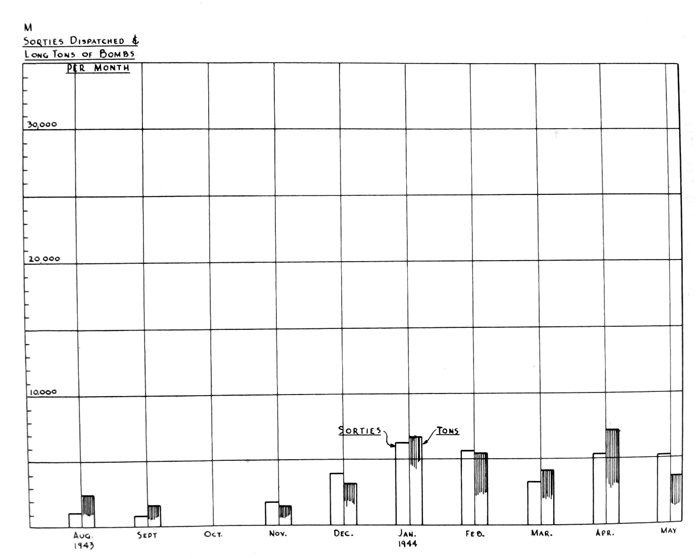
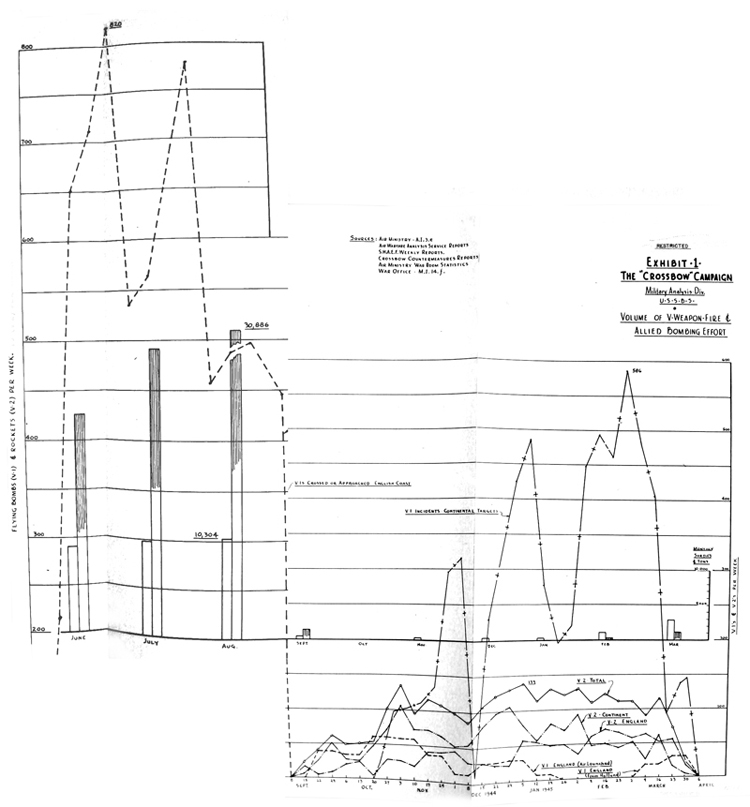
"Crossbow" Countermeasures - Distribution of Effort by Type of Target
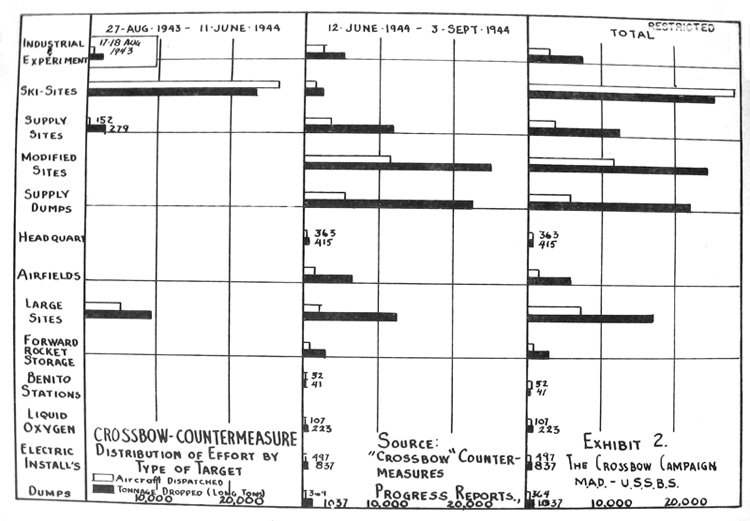
"Crossbow" Target Priorities
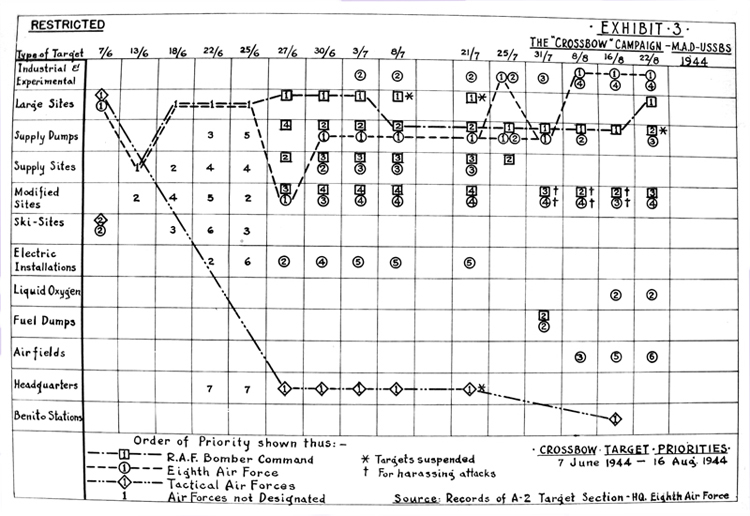
Total "Crossbow" Offensive Effort by Air Forces
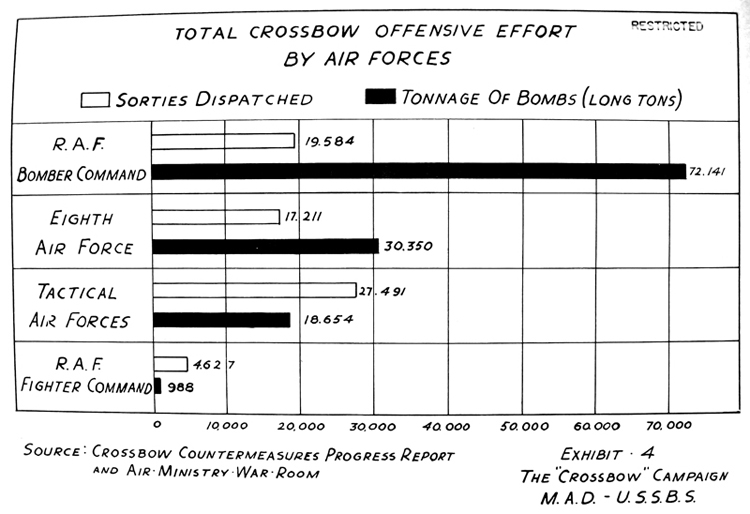
Cumulative Results of Attacks on "Ski-Sites"
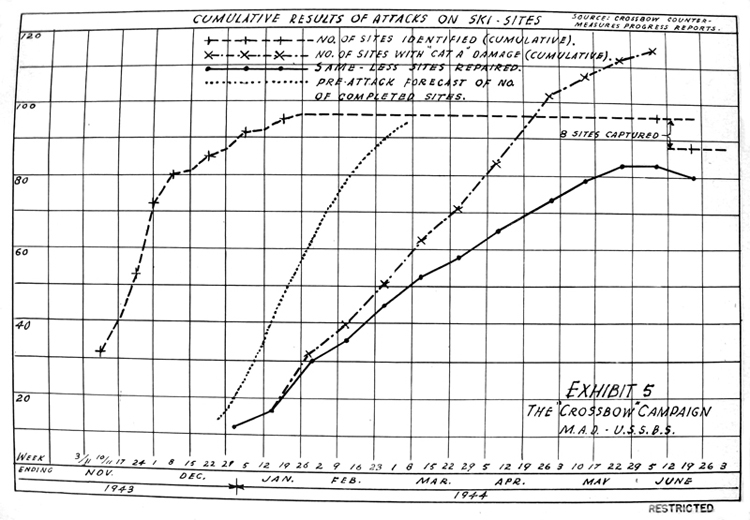
Cumulative Results of Attacks on "Modified Sites"
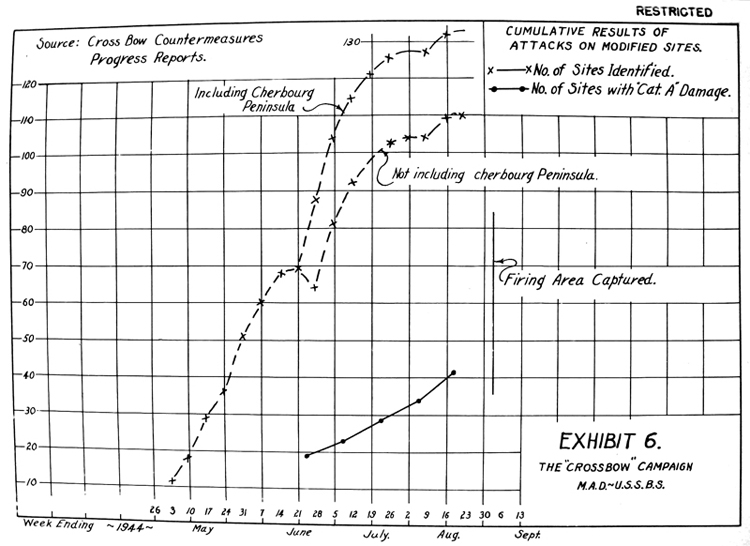
Monthly Effort by Air Forces - Offensive Sorties dispatched
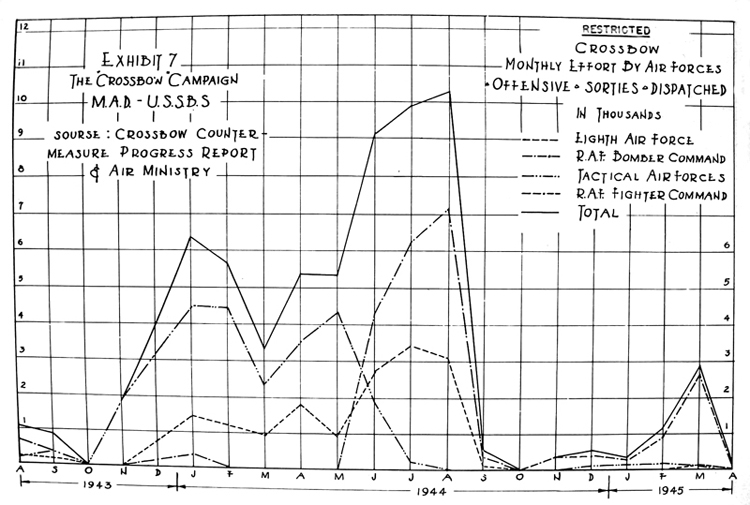
Monthly Effort by Air Forces - Tonnage of Bombs
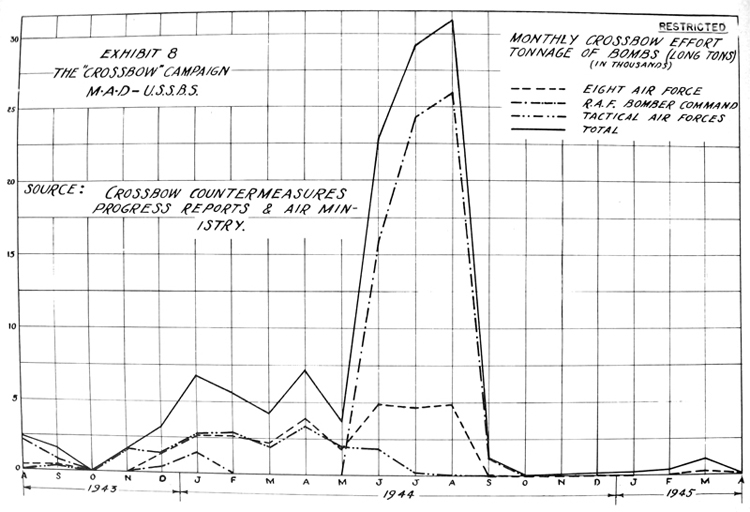
"Crossbow" Effort as a Percentage of Total Effort -Sorties
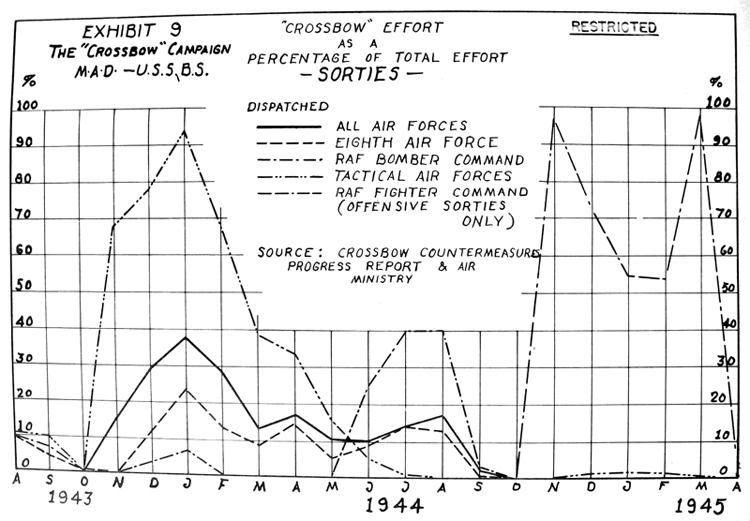
"Crossbow" Effort as a Percentage of Total Effort -Tonnage
